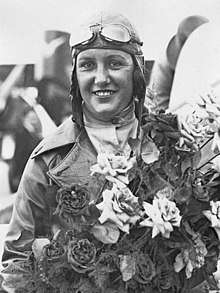Maryse Bastié
Maryse Bastié (27 February 1898 – 6 July 1952) was a French aviator who set several international records for female aviators during the 1930s.[1][2][3]

She was born Marie-Louise Bombec in Limoges, Haute-Vienne; Bastié's father died when she was eleven, and her family struggled to survive. As an adolescent she worked in a shoe factory, money was scarce and an early marriage that failed left her with a child, who died young, and limited means. As a result of her marriage to Louis Bastié, a World War I pilot, she became fascinated by the new phenomenon of powered flight and was determined to become a pilot and to own her own plane. She obtained her license to fly and although her husband was killed in a plane crash (in 1926), Maryse Bastié began doing aerobatics to earn money to keep herself flying and in 1927 purchased her own aircraft, a Caudron C.109.[2]
Records set by Maryse Bastié in the 1930s included international records for women in duration flying, distance, and a record time for a solo flight across the South Atlantic. Her performances earned her the Harmon Trophy in 1931. In 1935 she founded her own flying school at Orly Airport.[2]
Bastié served in the French Air Force, rising to the rank of Captain while logging more than 3,000 hours' flying time. The government of France made her a Commander of the Legion of Honor. In 1937, she published her story under the title Ailes ouvertes: carnet d'une aviatrice.[4]
On 6 July 1952, following a conference in Lyon, Maryse Bastié was killed when her plane crashed during take off.[1][2] She is buried in the Cimetière du Montparnasse in Paris.
Posthumous honors
The "Lycée professionnel régional Maryse Bastié" in Hayange-Marspich, the "Lycée Maryse Bastié" in Limoges, and the "College Maryse Bastié" in Reims as well as in Vélizy-Villacoublay are named in her memory. The Real Estate Services division of aircraft maker Bombardier Inc. named a street in her honor in Saint-Laurent, Quebec as did the French cities of Anglet, Bron, Haguenau, Châteaulin and Lyon.
In 1955, the Government of France honored Maryse Bastié with her image on an airmail postage stamp.[5]
There is a memorial to Maryse Bastile in the west of Paris in a small park of the Boulevard du Garigliano M. Valin not far from the Seine.
References
| Wikimedia Commons has media related to Maryse Bastié. |
- Maryse Bastié avait des ailes. france3-regions.francetvinfo.fr
- Maryse BASTIE 1898 – 1952. slhada.fr
- Bastié Maryse. aero-mondo.fr
- Maryse Bastié (1937) Ailes ouvertes: Carnet d'une aviatrice. Grasset
- Bastié Maryse. colnect.com
Further reading
- History Today article by Sian Reynolds, University of Sussex
- Ailes ouvertes : carnet d'une aviatrice. Maryse Bastié (1937) Fasquelle ASIN B0000DTBTE
- La Vie de Maryse Bastié. Marcel Migeo (1948) Editions du Seuil ISBN 2-02-004154-5
- Une Française, Maryse Bastié. Vice-Amiral Amanrich. (1953) Editions Baudiniere ASIN B0000DUSXE
- Une trace dans le ciel. Agnès Clancier (2017) Editions Arléa ISBN 9782363081407